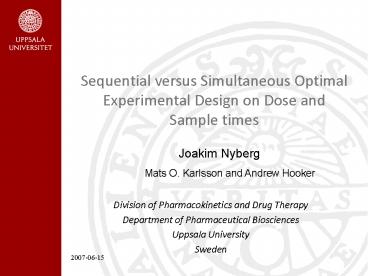Sequential versus Simultaneous Optimal Experimental Design on Dose and Sample times - PowerPoint PPT Presentation
Title:
Sequential versus Simultaneous Optimal Experimental Design on Dose and Sample times
Description:
Sequential versus Simultaneous Optimal Experimental Design on Dose and Sample times Joakim Nyberg Mats O. Karlsson and Andrew Hooker Background Traditionally Optimal ... – PowerPoint PPT presentation
Number of Views:142
Avg rating:3.0/5.0
Title: Sequential versus Simultaneous Optimal Experimental Design on Dose and Sample times
1
Sequential versus Simultaneous Optimal
Experimental Design on Dose and Sample times
Joakim Nyberg
Mats O. Karlsson and Andrew Hooker
2
Background
- Traditionally Optimal Design (OD) has been about
optimizing the sampling schedule in experiments. - But OD is dependent on ALL design parameters.
- Dose
- Covariates
- Number of samples/group
- Number of individuals/group
- Infusion duration
- Start/stop times of studies
- Start/stop times of infusion
- Wash out period length
- All other design parameters that you could think
of - Optimal design is a powerful tool, but it has not
been used widely for optimizing the problems
above. Optimal sampling times could be easy to
find by hand compared to many of these other
design parameters. - If optimizing on several design parameters,
should we do it simultaneously or sequentially?
3
Optimal Experimental Design
- Optimal Design is a way to find a design that
will produce as low uncertainty of the parameters
in a model as possible when re-estimating the
model with new data - Optimal Design only depends on the design
parameters and a prior model
4
Optimal Design and theFisher Information Matrix
- The theory behind optimal design uses the
Cramer-Rao inequality - Optimal Design only depends on the design
parameters and a prior model gt FIM only depends
on the design parameter and the prior model - Maximizing the determinant of the FIM is called
D-optimal design. Most common.
5
Experiment
- Optimize on a continuous dose and optimize on
continuous sample times - Design strategies
- Optimize sample time first, then dose
- Optimize dose first, then sample times
- Optimize dose and time simultaneously
- 1-5 groups (dose arms) with PK-PD measurements
- Used PopED in all experiments
Foracchia, M., Hooker, A., Vicini, P. and
Ruggeri, A., POPED, a software for optimal
experiment design in population kinetics. Comput
Methods Programs Biomed, 2004.
6
One-comp IV, direct effect E-max
Concentration
Effect
dose 2.75 mg
dose 2.75 mg
effect
conc. (mg/L)
time (h)
conc. (mg/L)
Y. Hashimoto L.B. Sheiner. Designs for
population pharmacodynamics value of
pharmacokinetic data and population analysis. J.
Pharmacokinetic. Biopharm 1991.
7
Experiment
- 1-5 groups
- 2 PK 3 PD samples in each group
- Different doses evenly spread (between groups)
0, 0.5-5 mg - Initial sample times evenly spread (within
groups) 0-1 h
8
Results, Different strategies, PK
Remember 2 PK samples/group, 5 groups gt A total
of 10 PK samples
9
Results, Different strategies, PD
Remember 3 PD samples/group, 5 groups gt A total
of 15 PD samples
10
Results, Different strategies, Dose
Optimal doses
4.967e32
Simultaneous
Time first
4.204e32
Dose first
3.764e32
dose (mg)
Remember 1 dose/group, 5 groups gt A total of 5
different doses
11
Results, Dose vs. PD Sample(1 group)
- Dose and sample times are correlated
12
Results, Dose vs. Dose(2 groups)
dose group 1 (mg)
dose group 2 (mg)
13
Results, Strategies, Difference
Change in FIM in compared to simultaneous
optimization (Difference)
Difference ()
14
Results, Strategies, Efficiency
Efficiency in of different strategies
Efficiency ()
where p number of parameters
15
Conclusions
- Its important to also optimize on dose in
optimal design - Its always more efficient to optimize
simultaneously compared to sequential optimization
16
Future perspectives
- Other areas where optimizing different design
parameters can be useful are - Drug-drug interaction studies e.g. wash out
periods - PET studies (plenty of samples)
- Provocation experiments (Glucose-Insulin)
- Multiple drug response studies
- Progression studies
- Functionality for this type of optimization has
already been done in PopED
17
Thank you































